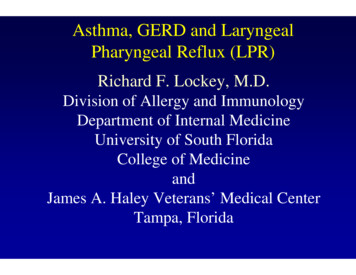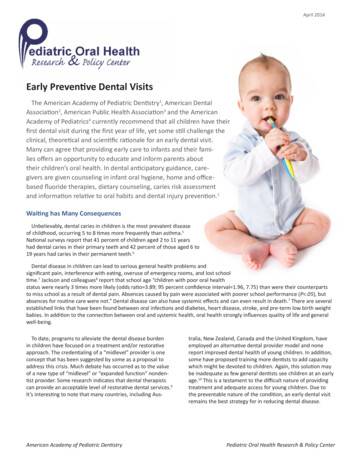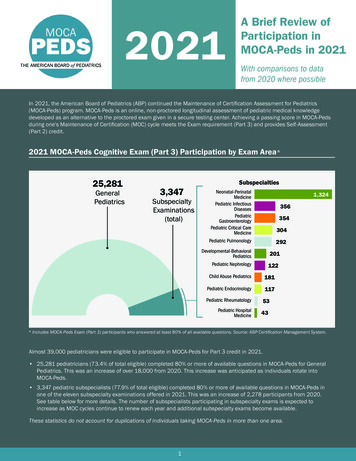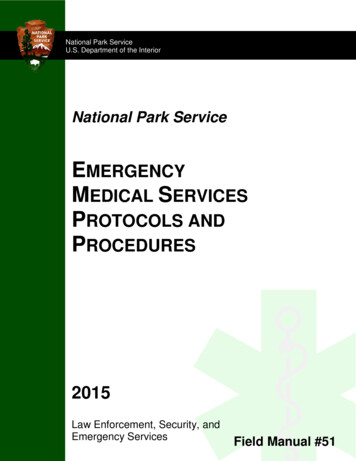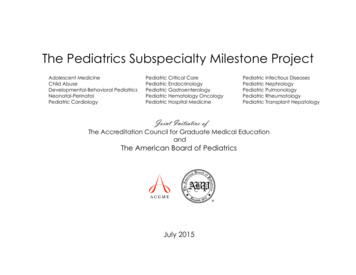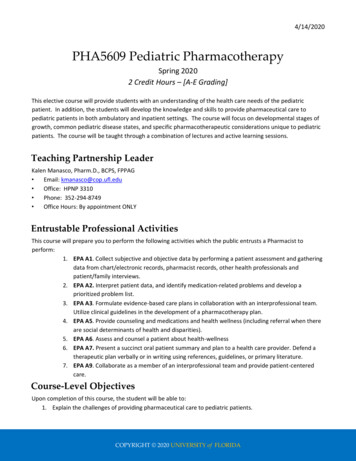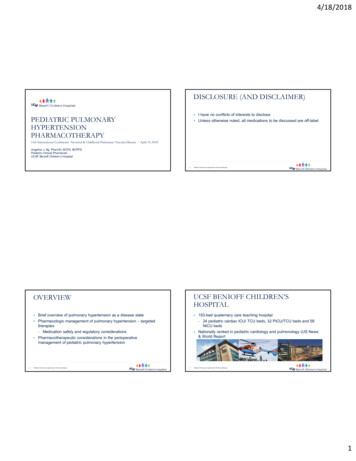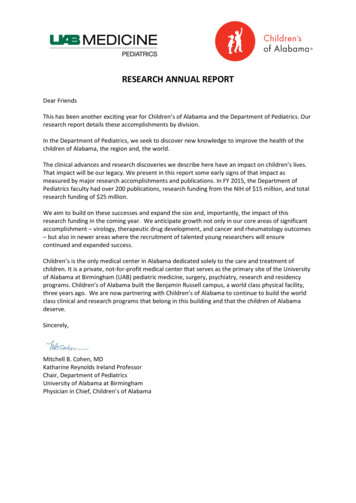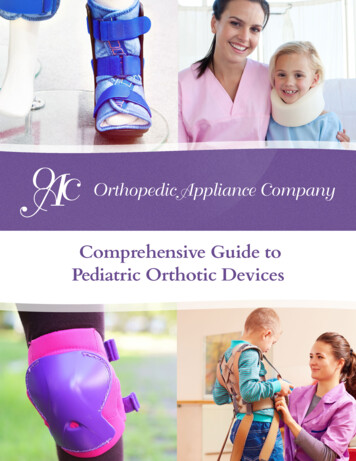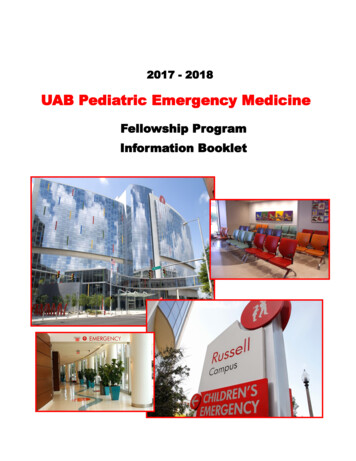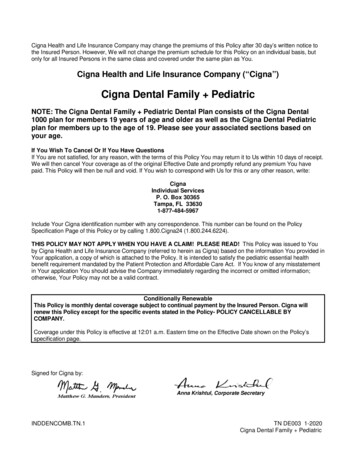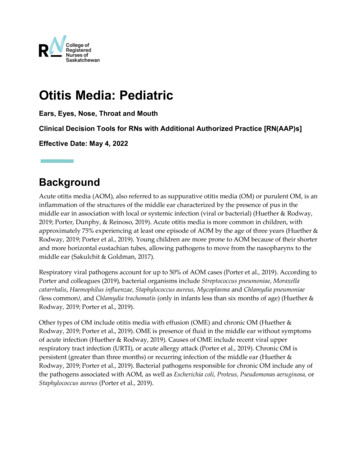
Transcription
Otitis Media: PediatricEars, Eyes, Nose, Throat and MouthClinical Decision Tools for RNs with Additional Authorized Practice [RN(AAP)s]Effective Date: May 4, 2022BackgroundAcute otitis media (AOM), also referred to as suppurative otitis media (OM) or purulent OM, is aninflammation of the structures of the middle ear characterized by the presence of pus in themiddle ear in association with local or systemic infection (viral or bacterial) (Huether & Rodway,2019; Porter, Dunphy, & Reinoso, 2019). Acute otitis media is more common in children, withapproximately 75% experiencing at least one episode of AOM by the age of three years (Huether &Rodway, 2019; Porter et al., 2019). Young children are more prone to AOM because of their shorterand more horizontal eustachian tubes, allowing pathogens to move from the nasopharynx to themiddle ear (Sakulchit & Goldman, 2017).Respiratory viral pathogens account for up to 50% of AOM cases (Porter et al., 2019). According toPorter and colleagues (2019), bacterial organisms include Streptococcus pneumoniae, Moraxellacatarrhalis, Haemophilus influenzae, Staphylococcus aureus, Mycoplasma and Chlamydia pneumoniae(less common), and Chlamydia trachomatis (only in infants less than six months of age) (Huether &Rodway, 2019; Porter et al., 2019).Other types of OM include otitis media with effusion (OME) and chronic OM (Huether &Rodway, 2019; Porter et al., 2019). OME is presence of fluid in the middle ear without symptomsof acute infection (Huether & Rodway, 2019). Causes of OME include recent viral upperrespiratory tract infection (URTI), or acute allergy attack (Porter et al., 2019). Chronic OM ispersistent (greater than three months) or recurring infection of the middle ear (Huether &Rodway, 2019; Porter et al., 2019). Bacterial pathogens responsible for chronic OM include any ofthe pathogens associated with AOM, as well as Escherichia coli, Proteus, Pseudomonas aeruginosa, orStaphylococcus aureus (Porter et al., 2019).
ENT Otitis Media - PediatricImmediate Consultation RequirementsThe RN(AAP) should seek immediate consultation from a physician/NP when any of thefollowing circumstances exist: toxic-appearing infant or child, may be pale or cyanotic and is oftenlethargic or inconsolably irritable. In addition, tachypnea and tachycardia with poor capillary refillmay be present;signs of meningeal irritation;mastoid process erythema, tenderness, swelling with fever, and protrusion of pinna;facial nerve palsy;lateral neck abscess;another bacterial infection is present;immunocompromised client;less than six months of age;failure of second round of antibiotic therapy;children who have frequent AOM (usually more than three episodes in six months or fourepisodes over a year period); and/orlethargy (Interprofessional Advisory Group [IPAG], personal communication August 28,2019). Predisposing and Risk FactorsPredisposing and risk factors for OM in pediatric clients include:age three months to three years,supine bottle feeding,formula feeding during the first six months of age,continued pacifier use after six months of age,eustachian tube dysfunction (due to allergies, sinusitis, rhinitis, or pharyngitis),recent or concurrent URTI,perforated tympanic membrane (TM) (due to direct blunt trauma, swimming or divingaccidents),immunosuppression,exposure to second-hand smoke,Down syndrome,daycare attendance,crowded or unsanitary living conditions,povertyexposure to wood-burning stoves,fall and winter months,male gender,craniofacial abnormalities (related to cleft palate, deviated nasal septum, or nasopharyngealtumours), and/orfamily history of OM (Anti-infective Review Panel, 2019; Porter et al., 2019; Coleman, Wood,Bialasiewicz, Ware, Marsh, & Cervin, 2018). 2Otitis Media - Pediatric 2022 College of Registered Nurses of Saskatchewan
ENT Otitis Media - PediatricHealth History and Physical ExamSubjective FindingsThe circumstances of the presenting complaint should be determined. These may include:otalgia (pain is absent in 20% of children);otorrhea;fever;irritability;tugging, rubbing, or holding of the ear;vomiting or diarrhea;restless sleep;history of URTI or recurrent AOM; and/orlethargy and anorexia (Porter et al., 2019; Sakulchit & Goldman, 2017). Clients with OME typically present with the following complaints:absence of pain and fever;recent history of URTI or allergic rhinitis;sensation of ear fullness;ear popping, crackling, or gurgling sounds;decreased hearing acuity; and/orvertigo (rare) (Porter et al., 2019). Clients with chronic OM typically present with the following complaints:history of repeated AOM,period of continuous or intermittent otorrhea for three months or more,hearing loss on the affected side, and/orpain (not common) (Porter et al., 2019). Objective FindingsThe signs and symptoms of OM in the pediatric client may include:fever;acutely ill appearance;absence of erythema or swelling of external ear canal;red, dull, cloudy or yellow TM, often bulging and opaque;obscured or inability to visualize bony landmarks in middle ear;absence of cone of light reflex;purulent or mucoid discharge in the external ear canal if the TM is perforated;decreased mobility of the TM; 3Otitis Media - Pediatric 2022 College of Registered Nurses of Saskatchewan
ENT Otitis Media - Pediatricbullae seen on TM (only in cases of Mycoplasma infection);enlarged and tender preauricular and posterior cervical nodes; and/orconductive hearing loss (Porter et al., 2019). Redness of the TM in the absence of other signs may be due to crying, agitation, a common cold,aggressive examination or manipulation of the external ear canal, myringitis, or OME (Porter etal., 2019).Differential DiagnosisThe following should be considered as part of the differential diagnosis:OME,chronic OM,acute otitis externa,temporomandibular joint syndrome,trauma to or foreign body in ear canal,referred pain from dental abscess,mastoiditis (rare),parotitis,transient middle ear effusion (due to air travel or altitude changes),eustachian tube disorders or nasopharyngeal pathology,allergic rhinitis, andmyringitis (Porter et al., 2019). Making the DiagnosisAcute otitis media in children can be diagnosed if there is middle ear effusion with signs of middleear inflammation on otoscopic exam such as:moderate or severe TM bulging on otoscope exam,new onset of otorrhea not caused by otitis externa, ormild bulging of the TM associated with recent onset of otalgia (within the last 48 hours) and/orerythema (Sakulchit & Goldman, 2017). Investigations and Diagnostic TestsInvestigations and diagnostic tests are not typically required if the history and physicalexamination support the diagnosis of OM (Porter et al., 2019).Management and InterventionsGoals of TreatmentThe primary goals of immediate treatment are to relieve pain and fever, eradicate infection,prevent complications and avoid unnecessary use of antibiotics to reduce antibiotic resistance. The4Otitis Media - Pediatric 2022 College of Registered Nurses of Saskatchewan
ENT Otitis Media - Pediatricmajority of uncomplicated cases of OM are self-limiting (up to 82%) and may not require specificinterventions other than pain control and symptomatic treatment (RxFiles Academic DetailingProgram, 2021; Porter et al., 2019).Non-Pharmacological InterventionsThe RN(AAP) should recommend, as appropriate, application of heat or cold to the outer ear,which may help with discomfort (Porter et al., 2019).Pharmacological InterventionsThe pharmacological interventions recommended for the treatment of OM in the pediatric clientare in accordance with the Anti-infective Guidelines for Community-acquired Infections (Anti-infective Review Panel, 2019), Antibiotic Therapy forChildren with Acute Otitis Media(Sakulchit & Goldman, 2017) and the RxFiles: Drug Comparison Charts (RxFiles AcademicDetailing Program, 2021).Treatment Principles for AOMAll drugs must be calculated by weight until 12 years of age. Doses should not exceedrecommended adult doses.A watchful waiting strategy is recommended for uncomplicated AOM in children older thansix months of age due to high spontaneous recovery rates (Anti-infective Review Panel, 2019).Observation and analgesic treatment for previously healthy children is recommended for 48-72hours before antibiotic therapy is initiated.This strategy can only be implemented when immediate follow-up by the caregiver can beguaranteed if symptoms worsen, new symptoms appear, or symptoms do not improve aftertwo to three days. If follow-up is unlikely, consider pharmacological treatment at initial visit.Clients with the following signs and symptoms should be considered to have severe illnessand antibiotics should be considered:o moderate to severe ear pain with fever 39 C,o bilateral AOM,o bulging TM,o systemic features,o vomiting, oro severe local signs (such as perforation with purulent discharge).Another option is a delayed prescribing strategy where an antibiotic prescription is to be filledif symptoms worsen or do not improve in 24 to 48 hours (Sakulchit & Goldman, 2019).Note that antihistamines, decongestants, intranasal or systemic corticosteroids, or topicalanalgesic ear drops are not effective for treating AOM or OME. 5Otitis Media - Pediatric 2022 College of Registered Nurses of Saskatchewan
ENT Otitis Media - PediatricAnalgesics and cAND/ORAcetaminophen10-15 mg/kg(maximum dailydose of75 mg/kg/day)p.o.q4-6h prn5-7 daysIbuprofen5-10 mg/kg(maximum dailydose of40 mg/kg/day)p.o.q6-8h prn5-7 daysOral Antibiotics (Client without TM perforation)Duration of antibiotic therapy for pediatric clients is 10 days for clients less than two years of age,five days for clients over the age of two years with an uncomplicated AOM, and 10 days for clientsover the age of two years with AOM and a perforated TM.High-dose amoxicillin should be considered for clients with an elevated risk of penicillin resistantS. pneumoniae (e.g., daycare, antibiotics exposure in past 3 months, less than 2 years of age). Secondline antibiotics (e.g., amoxicillin clavulanate) should be reserved for clients who have receivedamoxicillin in the past 30 days, are not responding to first line treatment after 48 to 72 hours orhave concurrent purulent conjunctivitis which is suggestive of Haemophilus influenzae.DrugDoseRouteFrequencyDurationPediatric ( 6 months) (First Line)ORAmoxicillin40-60 mg/kg per day(maximum daily doseof 1500 mg/day)p.o.t.i.d.5-10 daysAmoxicillin75-90 mg/kg per day(maximum daily doseof 3g/day)p.o.divided b.i.d.5-10 days(High dose)Pediatric ( 6 months) (Second Line)6Otitis Media - Pediatric 2022 College of Registered Nurses of Saskatchewan
ENT Otitis Media - PediatricORAmoxicillin/clavulanate 7:140-80 mg/kg/day(based on amoxicillincomponent; maximumdaily dose of 3 g/day)p.o.divided b.i.d.5-10 daysORCefprozil30 mg/kg/day(maximum daily doseof 1 g/day)p.o.divided b.i.d.5-10 daysDrugDoseRouteFrequencyDurationPediatric ( 6 months) (with penicillin allergy)ORClarithromycin15 mg/kg/day(maximum daily doseof 1g/day)p.o.divided b.i.d.5-10 daysAzithromycin10 mg/kg/day on day1 and then 5mg/kg/day on days 25 (Maximum dailydose of 500mg/day onday 1, and maximumdaily dose of 250mg/day on days 2-5)p.o.once daily5 daysTopical Antibiotics (Client with TM perforation)Topical preparations should be used with oral antibiotics only if there are signs of systemic illnesswhere signs of infection have spread beyond the middle and external ear.DrugDoseRouteFrequencyDurationPediatric ( 6 months of age) and AdultCiprofloxacin anddexamethasone(preferred)4 drops to affected eartopicalb.i.d.7 daysClient and Caregiver EducationThe RN(AAP) provides client and caregiver education:Counsel about appropriate use of medications (dose, frequency, compliance, etc.). 7Otitis Media - Pediatric 2022 College of Registered Nurses of Saskatchewan
ENT Otitis Media - PediatricAdvise on timelines of treatment and expected course of the disease process.Recommend increased rest in the acute pain and febrile phases.Avoid swimming until OM clears as water immersion could lead to otitis externa.Advise frequent and thorough hand washing to prevent transmission of concomitant upperrespiratory illness.Advise to keep the ear canal clean and dry during the course of the infection.Recommend avoidance of air travel until symptoms have resolved.Avoid feeding in a supine position. Educate about the prevention of AOM directed at riskfactor reduction including: breastfeeding during the first six months and longer if possible,reducing or eliminating pacifier use in the second six months of life, and avoidance of secondhand smoke exposure. Recommend immunizations if necessary (Anti-infective Review Panel,2019; Porter et al., 2019). Monitoring and Follow-UpShort term monitoring and follow-up:For those on observation, follow-up in two to three days for reassessment of AOM.Follow-up in 24 hours clients who have severe symptoms and recurrence as well as youngchildren.Advise caregiver of follow-up if symptoms do not improve in 48 hours or sooner if conditiondeteriorates (Anti-infective Review Panel, 2019; Porter et al., 2019). ComplicationsThe following complications may be associated with OM:perforated TM;chronic OM;hearing loss;speech, language, and cognitive disabilities;mastoiditis;meningitis (rare);facial nerve palsy;brain abscess (rare);labyrinthitis; orcholesteatoma (Huether & Radway, 2019). ReferralRefer to a physician/NP if client presentation is consistent with those identified in the ImmediateConsultation Requirements section, or if the client's pain is not managed with simple analgesics (e.g.,acetaminophen, ibuprofen) (IPAG, personal communication August 28, 2019).8Otitis Media - Pediatric 2022 College of Registered Nurses of Saskatchewan
ENT Otitis Media - PediatricReferencesAnti-Infective Review Panel. (2019). Anti-infective guidelines for community-acquired infections.MUMS Guideline Clearinghouse.Coleman, A., Wood, A., Bialasiewicz, S., Ware, R. S., Marsh, R. L., & Cervin, A. (2018). Theunsolved problem of otitis media in indigenous populations: A systematic review of upperrespiratory and middle ear microbiology in indigenous children with otitis media.Microbiome, 6(1), 199. https://doi.org/10.1186/s40168-018-0577-2Huether, S., & Rodway, G. (2019). Pain, temperature regulation, sleep, and sensory function. In K.McCance & S. Huether (Eds.), Pathophysiology: The biologic basis for disease in adults andchildren (8th ed., pp. 468-503). Elsevier.Porter, B., Dunphy, L., & Reinoso, H. (2019). Inflammatory and infectious disorders of the ear. InL. Dunphy, J. Winland-Brown, B. Porter, & D. Thomas (Eds.), Primary care: The art andscience of advanced practice nursing – an interprofessional approach (5th ed., pp. 306-319). F. A.Davis.RxFiles Academic Detailing Program. (2021). RxFiles: Drug comparison charts. (13th ed.). SaskatoonHealth Region.Sakulchit, T., & Goldman, R. (2017). Antibiotic therapy for children with acute otitis media.Canadian Family Physician, 63, 685-687. https://www.cfp.caNOTICE OF INTENDED USE OF THIS CLINICAL DECISION TOOLThis CRNS Clinical Decision Tool (CDT) exists solely for use in Saskatchewan by an RN with additionalauthorized practice as granted by the CRNS. The CDT is current as of the date of its publication andupdated every three years or as needed. A member must notify the CRNS if there has been a change in bestpractice regarding the CDT. This CDT does not relieve the RN with additional practice qualifications fromexercising sound professional RN judgment and responsibility to deliver safe, competent, ethical andculturally appropriate RN services. The RN must consult a physician/NP when clients’ needs necessitatedeviation from the CDT. While the CRNS has made every effort to ensure the CDT provides accurate andexpert information and guidance, it is impossible to predict the circumstances in which it may be used.Accordingly, to the extent permitted by law, the CRNS shall not be held liable to any person or entity withrespect to any loss or damage caused by what is contained or left out of this CDT.CRNS This CDT is to be reproduced only with the authorization of the CRNS.9Otitis Media - Pediatric 2022 College of Registered Nurses of Saskatchewan
5 Otitis Media - Pediatric 2022 College of Registered Nurses of Saskatchewan . ENT Otitis Media - Pediatric . majority of uncomplicated cases of OM are self-limiting (up to 82%) and may not require specific interventions other than pain control and symptomatic treatment (RxFiles Academic Detailing Program, 2021; Porter et al., 2019).
